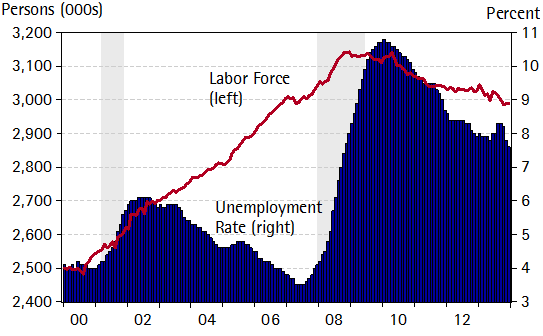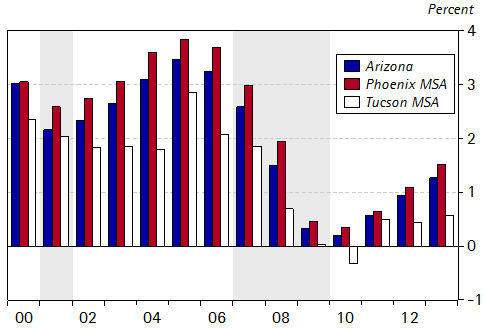By George W. Hammond, Ph.D.
EBRC Director and Eller Research Professor
March 1, 2014
According to the latest preliminary data, the Arizona economy weakened during the second half of 2013, with decelerating job growth and housing activity. Overall, the state added 50,900 jobs in 2013, which translates into a growth rate of 2.1%, the same as 2012. The forecast calls for state growth to overcome recent weakness and accelerate during the next three years, as the federal fiscal drag diminishes, residential construction picks up speed, and world growth strengthens.
U.S. Real GDP: Steady Gains End the Year
U.S. real GDP growth remained solid in the further quarter of 2013, at 2.4%, after strong third quarter growth of 4.1%. Growth in the fourth quarter was driven primarily by consumption spending, net exports, and investment spending. Real government spending declined during the fourth quarter, driven by the sequester and the federal government shutdown. Real residential investment spending declined in the fourth quarter, for the first time since the third quarter of 2010.
Last year marked another modest labor market improvement for the nation. Total nonfarm employment rose 1.7%, equal to the growth rate for 2012. The national unemployment rate declined for the third consecutive year in 2013, to 7.4%. However, this improvement was accompanied by a steady decline in labor force participation, which is down from 64.7% in 2010 to 63.2% in 2013. Part of the decline in labor force participation is being driven by baby boom retirements. However, since we have also seen declining labor force participation in the prime working age group (age 25-54) and this suggests that the labor market has still not fully recovered.
Arizona: A Slow Exit From 2013
The Arizona economy ended 2013 with slow job growth and a drop in the state unemployment rate that reflected a declining labor force, according to preliminary estimates. Arizona’s seasonally-adjusted job growth from the third quarter of 2013 to the fourth quarter was just 1.0% at an annualized rate. That was well below the 1.8% rate posted in the third quarter and below national job growth of 1.7% in the fourth quarter. [1]
Sluggish state gains in the final quarter of 2013 were driven by job declines in (in order of importance) professional and business services; leisure and hospitality; manufacturing; construction; information; and mining and logging. These quarter-to-quarter employment declines were more than offset by growth in (in order of importance) financial activities; trade, transportation and utilities; education and health care; government; and other services.
Overall, 2013 was another year of modest job growth in Arizona. On average, the state added 50,900 jobs, which translated into a growth rate of 2.1%. That was the same growth rate that the state posted in 2012, but Arizona again outpaced the national rate (of 1.7%).
Disappearing Labor Force

Exhibit 1: Arizona’s Unemployment Rate and Labor Force Have Both Declined Since 2010
Seasonally Adjusted Unemployment Rate and Civilian Labor Force
Arizona’s seasonally adjusted unemployment rate declined to 7.9% in the fourth quarter of 2013, down from 8.2% in the third quarter. On average for 2013, that puts the state rate at 8.0%, down slightly from 8.3% on average in 2012 and well down from the 10.4% average in 2010. However, as Exhibit 1 shows, the state’s labor force has also declined since 2010. Thus, Arizona’s declining unemployment rate reflects, in part, residents dropping out of the state’s labor force. Demographics are contributing to this trend, as baby boomers begin to retire in larger numbers. It also likely reflects sluggish job growth, which remains well below average growth during the 31 years preceding the Great Recession (4.2% per year).
Construction Stumbles
State construction activity softened during the second half of 2013, with construction jobs, housing permits, and house price increases weakening. Seasonally adjusted construction employment declined during both the third and fourth quarters of 2013. Likewise, total housing permits declined in the second half of 2013, driven by lower multi-family activity. House price appreciation peaked near the end of 2012 and gradually decelerated during most of 2013, although growth remained rapid in Phoenix. Slowing housing activity was likely related a variety of factors, including reduced demand from owner-occupiers and investors, as well as supply-side constraints (high lot prices in desirable areas and labor shortages in construction).
Population Gains Accelerate
The Arizona Department of Administration recently released its mid-year population estimates for 2013. The estimates suggest that the state added 82,485 residents from July 1, 2012 to July 1, 2013, which translates into a growth rate of 1.3%. That was nearly double the national growth rate of 0.7%. As Exhibit 2 shows, Arizona’s population growth has now accelerated for three consecutive years. The exhibit also makes clear that state population growth remains well below the average rate during the previous decade (2.4%). Further, state growth is also below the average rate posted during the 1976-2007 period (the 31 years before the Great Recession) of 3.2% per year.

Exhibit 2: Arizona’s Population Growth Accelerates
Population Estimates from the Arizona Department of Administration
The exhibit also shows a similar pattern of acceleration in population growth for the Phoenix MSA, which is estimated to have added 64,775 net new residents from mid-2012 to mid-2013. That implies a growth rate of 1.5%, more than double the national rate. The Tucson MSA also added residents during the same period, with an increase of 5,666 (or 0.6%).
Arizona Outlook: A Little Better This Year
The state economy is forecast to gradually gain momentum during the next three years. This acceleration in growth is driven by reduced federal fiscal drag, increased residential mobility nationally (which means more migration to Arizona), and stronger U.S. and world growth.
The state economy is forecast to post slightly stronger job growth in 2014, with the rate accelerating from 2.1% in 2013 to 2.5% in 2014. Job growth is expected to continue to rise in 2015 and 2016, to 3.4% and 3.6%, respectively. Even so, growth remains well below average gains that the state posted during the 31 years before the Great Recession (4.2% per year).
Income growth also accelerates during the next three years, reflecting improved job growth, as well as continued gains in capital income (dividends, interest, and rent) and transfer payments (Social Security, Medicare, Medicaid, and welfare payments).
Population growth also bounces back during the next three years, but remains well below average growth posted before the Great Recession (3.2% per year). This reflects accelerating net migration into the state, as U.S. residential mobility improves.
Rising population growth drives gains in housing activity, with housing permits expected to exceed 50,000 units by 2015. Both single-family and multi-family are expected to improve in the near term.
Both the Phoenix and Tucson MSAs are expected to post improved economic growth during the next three years, but the gains are forecast to be most rapid in Phoenix. The pattern of job growth across industries for both is expected to be similar for both Phoenix and Tucson, with service-providing sectors dominating job gains.
[1] CES employment benchmarked by EBR to June 2013.
Businessman with Gears courtesy Shutterstock.





